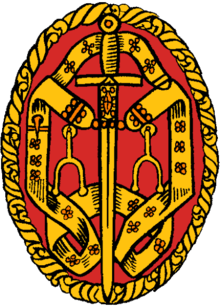Derek Barton
| Sir Derek Barton | |
|---|---|
| Born |
Derek Harold Richard Barton 8 September 1918 Gravesend, Kent |
| Died |
16 March 1998 (aged 79) College Station, Texas, USA |
| Resting place | La Grange Cemetery, Texas |
| Nationality |
|
| Fields | Chemistry |
| Institutions | |
| Alma mater | Imperial College London |
| Doctoral advisor | Ian Heilbron |
| Doctoral students | |
| Known for | |
| Notable awards |
|

Sir Derek Harold Richard Barton PhD FRS FRSE [1] (8 September 1918 – 16 March 1998) was an English organic chemist and Nobel Prize laureate for 1969.[2][3][4][5][6]
Education and early life
Barton was born in Gravesend, Kent, to William Thomas and Maude Henrietta Barton (née Lukes).
He attended Gravesend Grammar School (1926–29), The King's School, Rochester (1929–32), Tonbridge School (1932–35) and Medway Technical College (1937–39). In 1938 he entered Imperial College London, where he graduated in 1940 and obtained his PhD degree in Organic Chemistry in 1942.
Career and research
From 1942 to 1944 he was a government research chemist, from 1944 to 1945 he was with Albright and Wilson in Birmingham. He then became Assistant Lecturer in the Department of Chemistry of Imperial College, and from 1946 to 1949 he was ICI Research Fellow.
During 1949 and 1950 he was Visiting Lecturer in Natural Products Chemistry at Harvard University, and was then appointed Reader in Organic Chemistry and, in 1953, Professor at Birkbeck College. In 1955 he became Regius Professor of Chemistry at the University of Glasgow, in 1957 he was appointed Professor of Organic Chemistry at Imperial College. In 1950, Professor Barton showed that organic molecules could be assigned a preferred conformation based upon results accumulated by chemical physicists, in particular by Odd Hassel. Using this new technique of conformational analysis, he later determined the geometry of many other natural product molecules. In 1969, Barton shared the Nobel Prize in Chemistry with Odd Hassel for "contributions to the development of the concept of conformation and its application in chemistry."
In 1958 Professor Barton was appointed Arthur D. Little Visiting Professor of Massachusetts Institute of Technology, and in 1959 Karl Folkers Visiting Professor of Illinois and Wisconsin Universities. In 1960 he was appointed a Visiting Professor of the University of California, Berkeley, spending much of his time with the W.H. Dauben Group. The same year he was elected a Foreign Honorary Member of the American Academy of Arts and Sciences.[7]
In 1949 he was the first recipient of the Corday-Morgan Medal and Prize awarded by the Royal Society of Chemistry. In 1954 he was elected a Fellow of the Royal Society and the International Academy of Science as well as, in 1956, a Fellow of the Royal Society of Edinburgh; in 1965 he was appointed member of the Council for Scientific Policy. He was knighted in 1972, becoming formally styled Sir Derek in Britain. In 1978 he became Director of the Institut de Chimie des Substances Naturelles (ICSN - Gif Sur-Yvette) in France.
In 1977, on the occasion of the centenary of the Royal Institute of Chemistry, the British Post Office honoured him, and 5 other Nobel Prize-winning British chemists, with a series of 4 postage stamps featuring aspects of their discoveries.[8]
In 1986 he became Distinguished Professor at Texas A&M University and held this position for 12 years until his death.
In 1996, Professor Barton published a comprehensive volume of his works, entitled Reason and Imagination: Reflections on Research in Organic Chemistry.
As well as for his work on conformation, his name is remembered in a number of reactions in organic chemistry such as the Barton reaction, the Barton decarboxylation, and the Barton-McCombie deoxygenation. Barton is the doctoral advisor of David Crich, a prestigious chemistry professor at Wayne State University.
Honours and awards
Barton was elected a Fellow of the Royal Society (FRS) in 1954.[1]
-
 - Knight Bachelor (1972)
- Knight Bachelor (1972) -
 - Légion d'honneur (1972)
- Légion d'honneur (1972)
Personal life
Sir Derek married three times, and had a son by his first marriage; he died at College Station, Texas.
References
- 1 2 3 Ley, S. V.; Myers, R. M. (2002). "Sir Derek Harold Richard Barton. 8 September 1918 - 16 March 1998". Biographical Memoirs of Fellows of the Royal Society. 48: 1. doi:10.1098/rsbm.2002.0001. JSTOR 3650246.
- ↑ Albert Cotton, F. (2000). "Derek H. R. Barton, 8 September 1918 · 16 March 1998". Proceedings of the American Philosophical Society. 144 (3): 292–296. doi:10.2307/1515591.
- ↑ Barton's Nobel Foundation biography of Barton
- ↑ Barton's Nobel Lecture The Principles of Conformational Analysis
- ↑ Video podcast of Barton talking about conformational analysis
- ↑ MDPI biography of Barton doi:10.3390/30400132
- ↑ "Book of Members, 1780-2010: Chapter B" (PDF). American Academy of Arts and Sciences. Retrieved 19 May 2011.
- ↑ New Scientist 10 Feb. 1977 p. 319
